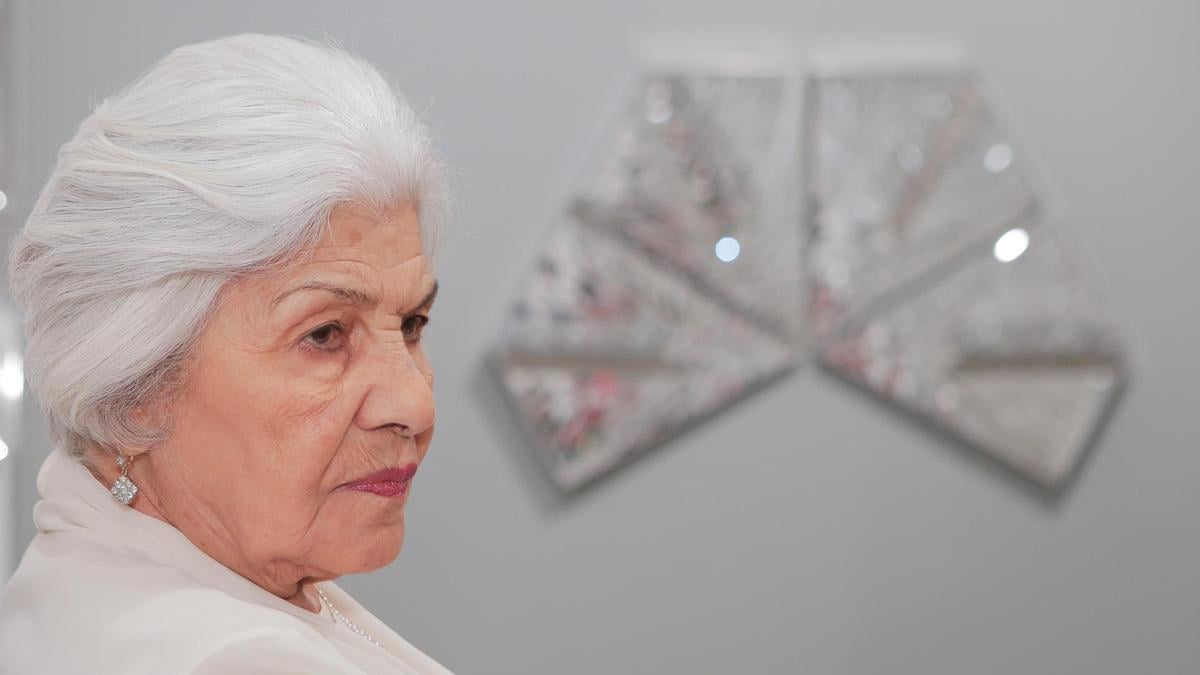
Iranian artist Monir Shahroudy Farmanfarmaian, who achieved renown late in life for her dazzling mirrored mosaic works and glass paintings, has died at age 97.
“Monir will always be remembered for her unwavering strength, her eternally young and curious spirit, and the many lives she has touched through her friendship and her work,” her gallery, the Third Line in Dubai, said in a statement.
Farmanfarmaian was born in 1922 to an aristocratic family in Qazvin, Iran. She studied at the University of Tehran and moved to New York in 1944, continuing her education at Cornell University, the Art Students League, and Parsons Design School, where she encountered nude models for the first time. During her time in the city, Farmanfarmaian befriended Andy Warhol, with whom she worked as an illustrator at the department store Bonwit Teller, as well as fellow artists Joan Mitchell, Jackson Pollock, and Willem de Kooning.
She returned to Tehran in 1957 and developed a unique practice rooted both in minimalism and abstraction as well as traditional Iranian art, with its Islamic influenced and predominantly geometric forms. Farmanfarmaian was inspired by the Iranian technique of Aineh Kari, developed in the 16th century as a way of using shards of imported European glass when it arrived broken.
Monir Shahroudy Farmanfarmaian, Hexagon (Fourth Family), 2013. Photo courtesy the Third Line.
She first began her explorations of mirror mosaics in 1966, after a visit to the Shah Cheragh mosque in Shiraz, Iran, left her in awe of the mirrored reflections of visitors from all walks of life. Farmanfarmaian’s 2013 memoir recalled with reverence how “architecture transformed into performance, all movement and fluid light, all solids fractured and dissolved in brilliance in space, in prayer”—a phenomenon she sought to replicate in her practice.
Forced into exile following Iran’s 1979 revolution, Farmanfarmaian saw many of her works destroyed. She returned to New York with her second husband, Abolbashar Farmanfarmaian, for 26 years before moving back to Tehran in 2004.
Monir Shahroudy Farmanfarmaian. Photo courtesy of the Third Line, Dubai.
Despite her long career, she didn’t receive her first comprehensive US solo show until New York’s Solomon R. Guggenheim Museum staged “Monir Shahroudy Farmanfarmaian: Infinite Possibility” in 2015. Curated by Suzanne Cotter, the show originated at the Fundação de Serralves in Porto, Portugal.
“In America, after the revolution, after the [Gulf] war, nobody wanted to do anything with Iran,” Farmanfarmaian told the Guardian in 2011. “None of the galleries wanted to talk to me. And after September 11—my God. No way. Rather than being a woman, it was difficult just being Iranian.”
Recognition came earlier in her home country. Farmanfarmaian won a gold medal for her presentation at the Iran Pavilion in the 1958 Venice Biennale. In 2017, the Monir Museum at the University of Tehran’s Negarestan Museum Park Gardens became the country’s first museum dedicated to a female artist.
Farmanfarmaian’s work appears in such major collections as the Museum of Contemporary Art, Chicago; the Metropolitan Museum of Art, New York; the Victoria and Albert Museum’s Jameel Collection, London; the Queensland Art Gallery, Australia; and the Tehran Museum of Contemporary Art.
Her most recent solo show, “Monir Shahroudy Farmanfarmaian: Sunset, Sunrise,” opened in 2018 at the Irish Museum of Modern Art, Dublin, and will travel to the Sharjah Art Foundation in the United Arab Emirates later this year.